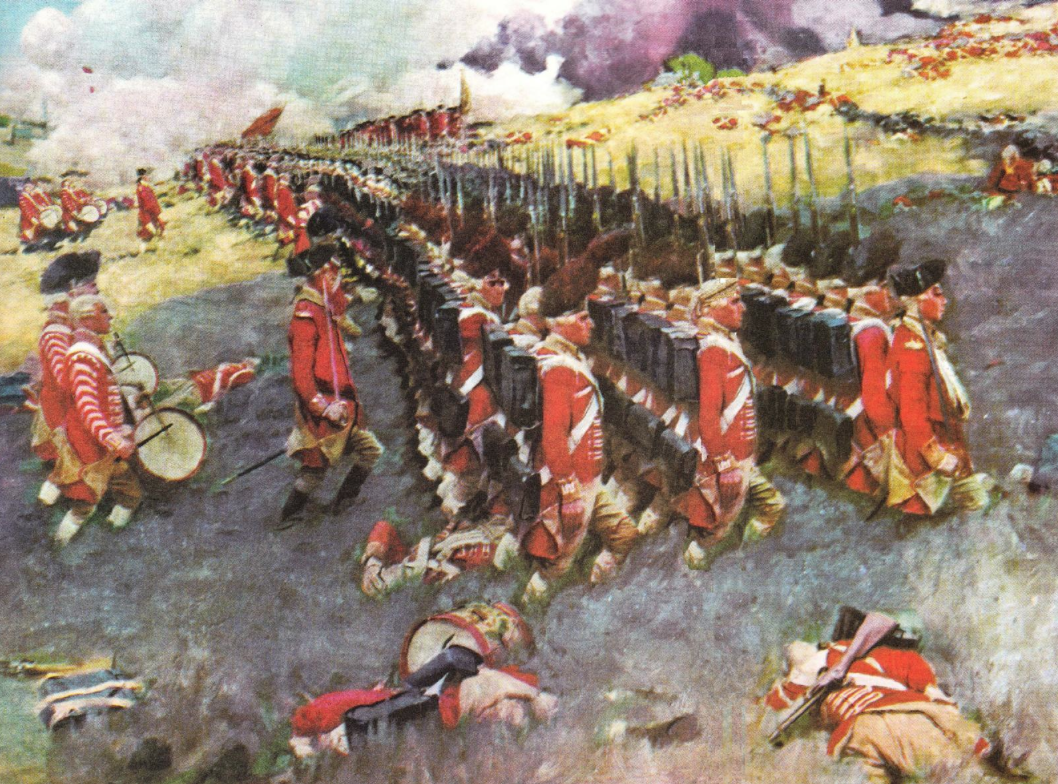By Len Abram
The fact slips by you like a road sign at sixty miles-per-hour, hardly noticed because you are enjoying the ride. Nathaniel Philbrick’s book of one of America’s famous battles, “Bunker Hill: A City, a Siege, a Revolution,” (Penguin, 2013. 396 pages) is not about an American victory, but an American defeat.
Victory has many fathers, to paraphrase John F. Kennedy, while defeat is an orphan. Massachusetts and the nation readily adopted this defeat. Bunker Hill was a Pyrrhic victory for the British, that is, much too costly. The British might still win the war, but not as easily as they anticipated.
The colonists were prepared for war because they had practice in its blood-spattered school. First, they fought in the King Philip War against Native Americans, in which a third of the settlements in New England were torched. Secondly, as British allies in the French and Indian War, the colonists learned the arts of attack and siege, the predicament the English found themselves in Boston in 1775 with their backs to the sea.
Philbrick traces the painful separation between colony and mother country. The transition from colonist to patriot, from subject to citizen, happened with the colonists’ growing frustration over laws and taxes passed by a legislature three thousand miles away. The colonists were used to self-government and local militias. When the disputes between England and the colonies moved beyond negotiation, one side or the other would use force to compel compliance.
The fighting started in Lexington and Concord. British regulars left the safety of Boston to deny the colonists the ability to resist. Confiscating gunpowder, in short supply, was the surest way to end the fighting. The regulars never got that far as they met resistance, even if the militia had fortified their courage with visits to the neighborhood tavern. These were skirmishes where terrain, such as the long road back to Boston, nullified British strength. The first real battle, Philbrick shows, where British army discipline, equipment and skill were at their best, would take place at Breed’s Hill and at Bunker Hill in Charlestown.
Unless the British broke out of the siege in Boston, eventually they would have to evacuate. British strategy, in fact, favored the central part of the colonies, New York and New Jersey, as more important than New England. Control there split the colonies. Boston was not critical.
To stay in Boston, however, the British would have to keep their enemy off the heights overlooking the city. Cannon on hilly Charlestown or Dorchester threatened the occupation and the ships supplying it. When American forces fortified Breed’s Hill in Charlestown, they challenged the British to battle, which the British welcomed to put an end to the insurrection.
The British launched three attacks on the 110-foot rise of the Charlestown hills. With the third, the British overwhelmed the Americans. The oft-quoted command about not firing until the patriots saw the whites of British eyes was really the whites of the gaiters British troops wore.
British General Howe and his staff expected to face an American mob easily routed. Howe brought with him his valet and a bottle of wine to celebrate the victory. Both the wine and valet were hit. British forces suffered over a thousand dead or wounded, about 40 percent of the troops and officers. American losses were a third of the Regulars. The death of Dr. Joseph Warren, patriot leader, the hero of Philbrick’s history, was an irreplaceable loss.
Philbrick writes like a novelist. Historical figures, a traitor like Benjamin Church or a leader like George Washington, are complex. Church is disloyal to his own wife, but loyal to the British Crown. He spies on the patriots because he believes them to be the real traitors. As for Washington, Philbrick treats the legend as a man with well-known virtues but neglected flaws. Philbrick suggests that Dr. Joseph Warren, had he lived, would have replaced Washington as commander. Warren could have been our first President.
Another outstanding patriot is Henry Knox. Knox led the group, which took cannon by oxen from Fort Ticonderoga in New York to Dorchester Heights overlooking Boston, forcing the British evacuation, still celebrated.
Philbrick frames his history with symmetry. In 1775, John Quincy Adams as a boy watches the Bunker Hill battle from Braintree. The book ends in 1843, as the distinguished Adams, former President, is invited to the dedication of the monument in Charlestown. Adams refuses to take much joy in the event because he is so opposed to slavery, still lawful.
Slavery in America cast shadows on the American Revolution. Fighting for liberty means liberty for all men, Adams would suggest. The Civil War was in the offing, where battles, far greater than what Adams witnessed at Bunker Hill, lay ahead.








Leave a Review or Comment